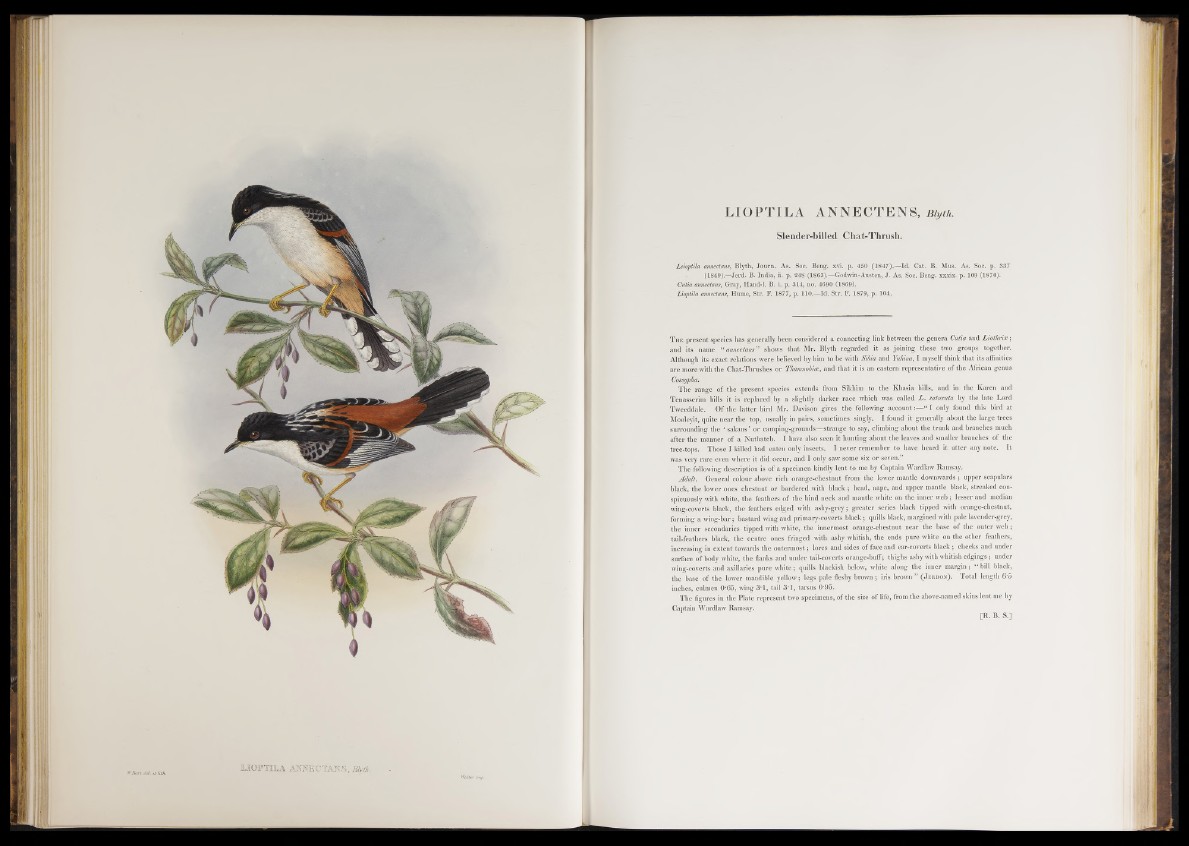
UQPTJDLA ASNECTAKS, Bl^th
LIOPTILA ANNECTENS, Biyth.
Slender-billed Chat-Thrush.
Leioptila annectans, Blyth, Journ. As. Soc. Beng. xvi. p. 45.0 (1 847).—Id. Cat. B. Mus. As. Soc. p. 337
(1849).—Jerd. B. India, ii. p. 248 (1863).— Godwin-Austen, J. As. Soc. Beng. xxxix. p. 109 (1870).
Cutia annectans, Gray, Hand-1. B. i. p. 314, no. 4690 (1869).
Lioptila annectans, Hume, Str. F. 1877, p. 110.— Id. Str. F. 1879, p. 104.
T h e present species has generally been considered a connecting link between the genera Cutia and L iothrix;
and its name “ annectans” shows that Mr. Blyth regarded it as joining these two groups together.
Although its exact relations were believed by him to be with Sibia and Yuhina, I myself think that its affinities
are more with the Chat-Thrushes or Thamnobice, and that it is an eastern representative o f the African genus
Cossypha.
The range of the present species extends from Sikhim to the Khasia hills, and in the Karen and
Tenasserim hills it is replaced by a slightly darker race which was called L . saturata by the late Lord
Tweeddale. Of the latter bird Mr. Davison gives the following a c c o u n t I only found this bird at
Mooleyit, quite near the top, usually in pairs, sometimes singly. I found it generally about the large trees
surrounding the ‘ sakans ’ or camping-grounds—strange to say, climbing about the trunk and branches much
after the manner o f a Nuthatch. I have also seen it hunting about the leaves and smaller branches of the
tree-tops. Those I killed had eaten only insects. I never remember to have heard it utter any note. It
was very rare even where it did occur, and I only saw some six or seven.”
The following description is of a specimen kindly lent to me by Captain Wardlaw Ramsay.
Adult. General colour above rich orange-chestnut from the lower mantle downwards ; upper scapulars
black, the lower ones chestnut or bordered with black ; head, nape, and upper mantle black, streaked conspicuously
with white, the feathers o f the hind neck and mantle white on the inner web; lesser and median
wing-coverts black, the feathers edged with ashy-grey; greater series black tipped with orange-chestnut,
forming a wing-bar; bastard wing and priinary-coverts black; quills black, margined with pale lavender-grey,
the inner secondaries tipped with white, the innermost orange-chestnut near the base o f the outer web;
tail-feathers black, the centre ones fringed with ashy whitish, the ends pure white on the other feathers,
increasing in extent towards the outermost; lores and sides of face and ear-coverts black ; cheeks and under
surface of body white, the flanks and under tail-coverts orange-buff; thighs ashy with whitish edgings; under
wing-coverts and axillaries pure white; quills blackish below, white along the inner margin; “ bill black,
the base of the lower mandible yellow; legs pale fleshy brown ; iris brown ” ( J erdon) . Total length 6-5
inches, culmen 0 ‘65, wing 3*1, tail 3*1, tarsus 0*95.
The figures in the Plate represent two specimens, o f the size of life, from the above-named skins lent me by
Captain Wardlaw Ramsay.